“This post contains affiliate links. If you shop using these links I make a small commission, but you are never charged any extra! And as always, my opinions are completely my own.”
The new year is the perfect time to try something new. Many people make New Year’s Resolutions to be more active or get out of the house more. Are you looking for a new outdoor activity for your nerd?
Archery is a must for all nerds. It helps your nerd focus, is a great way to stretch, and is a great way to get your nerd out exercising.
It also can help improve your nerd’s concentration. When you are aiming and shooting at a target, concentration is vital. You will be able to block out all distractions and just focus on your breathing and the target. Archery is a great way to get nerds with brains that are sometimes scattered to focus. When shooting, you are able to flex and stretch those neck and shoulder muscles that can get tight when sitting at a computer all day. Archery is a really good way to get your nerd to exercise. They will be walking back and forth the whole time while collecting your arrows as well as drawing the bow and stretching those muscles. In addition to being very cool, it is a great way to get exercise.
There are a few things you need to know when looking at archery as a new hobby: bow types, arrow types, and additional gear.
Bow Types
There are two main types of bows: recurve bows and compound bows.
Recurve bows are the ones that you see in movies and in the Olympics. They are used for target shooting and they have a sleek design. They are a great choice for new archers because they are simple and easy to use.
Compound bows are normally associated with hunting because they are able to shoot with incredible speed and force. There are rounded wheels that hold the drawstring. These wheels are called cams. They are used to multiply or “compound” the force used to push the arrow forward. This creates more speed than with a recurve bow.
Bow Structure
There are some basic parts of the bow that are applicable to both bow types:
The Riser. This is where you hold when you shoot. It is the handle of the bow.
The Limbs. Limbs are attached to the riser. This is the part that forms the actual bow, with the top limb attached by the bowstring to the bottom limb.
The Bow String. This is the string that connects the top and bottom limbs.
The Nock Point. This is the spot on the bowstring where you place the end of the arrow. The nocking point is locked into position so that you can aim and shoot consistently.
The Bow Sight. The bow sight is like the scope on a rifle. Once you have adjusted it properly, the sight allows you to aim at your target.
A recurve bow that I would recommend for a beginner is the Samick Sage Takedown Recurve Bow. It’s easy to use, easy to set up, and easy to customize. You can add an arrow rest and a bow sight without too much effort.
For compounds, I recommend the Genesis Kit. It’s a good option for new archers. It is easy to use and has an adjustable draw weight ranging from 10 to 20 pounds. The kit comes with a quiver, an arm guard, five aluminum arrows, and a hex wrench that you can use to adjust the draw weight of the bow.
To get access to our Resource Library, subscribe here.
Arrows
There are three main types of arrows: wood, aluminum, and carbon. Each arrow type has specific qualities and specific uses:
Wood Arrows. This is the original arrow and If you get into traditional archery, you will learn to love wooden arrows. Many people also learn to make their own arrows. You normally use wooden arrows with a recurve bow. You shouldn’t use them with a compound bow because they tend to snap due to the force.
Aluminum Arrows. These are great for beginners, and they can be used with either a recurve or a compound bow. If you go to an archery range, you’ll probably see a lot of aluminum arrows.
Carbon Arrows. These are very strong bows that are normally used with a compound bow and by hunters. Their strength allows them to be shot with great force without breaking. They can also be used with a recurve bow.
Arrow Structure
Here are some terms you will want to know when learning about arrows:
Arrowhead. This is the pointy part at the front of an arrow. Arrowheads can be different weights and shapes depending on what they are used for. They will range from very blunt to super, super, super sharp.
Fletching. These are the vanes on an arrow. The arrows for practice are made of feathers and the ones for hunting are made with plastic. Normally, there is one vane on the arrow that’s a different color than the other two vanes, and that’s called the index vane.
Shaft. This is the body of the arrow—the part between the arrowhead and the fletching.
Nock. This is the back forked end of the arrow, that fits into the bow string.
There are two arrows that I would recommend for beginners: Easton Jazz Aluminum Arrows and the Carbon Express Maxima RED
. Both of these are sturdy and have plastic vanes., which are great for practice.
Additional Gear
ARchery requires quite a bit of gear. There are a few things that you will need before you jump into archery and a few things that, while not necessary, are nice to have.
Arm Guards
Arm guards shield your inner arm from getting hit with the bowstring after you release an arrow. It is one of the most important pieces of equipment. You should always wear arm guards. Getting hit with the bowstring doesn’t sound like it would be extremely painful, but it is. I recommend the SAS Armguard because it’s thick and provides a lot of coverage. It’s got buckles, though, which some people don’t like. If you do not want buckles I suggest the OMP Mountain Man Arm Guard
, which has straps and Velcro and can be a little bit easier to adjust.
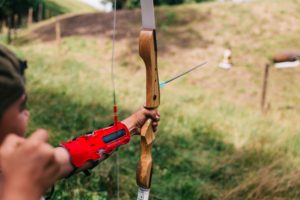
Bow Releases
There are two main types of bow releases. You can either use a glove or a tab. Bow releases for recurves are pretty simple. For a glove release, I recommend the FitsT4 Archery Gloves. It tends to stay in place and is very comfortable to use. If you want to use a tab release, I recommend the CyberDyer Leather Archery Finger Tab
. Bow releases for compounds can get pretty complicated quickly, but the option I would recommend for beginners is the TruFire Adjustable Bow Release
It’s got a trigger release, which makes it easier for beginners.
Bow Sights
A sight will help you aim. Recurve bows don’t normally come with a bow sight, but they are easy to install on your own. It’s important to have one that you are able to adjust after each shot. I recommend the e5e10 Recurve Bow Sight. Compound bows usually come with a bow sight. If yours does not, check with the manufacturer to see what they recommend.
Quivers
There are a lot of different types of quivers available—hip quivers, back quivers, and quivers you can attach directly to your riser. Hip quivers are the most common for target shooting. I recommend the Easton Flipside Hip Quiver. It clips to your belt or pants, has a few compartments for tools or whatever, and it comfortably holds a dozen arrows.
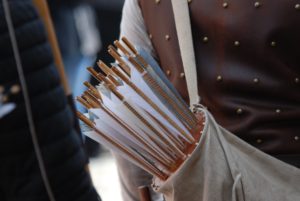
Archery is a great nerd activity. Between Lord of the Rings and preparing for the zombie apocalypse, your nerd will have no trouble appreciating archery.
For more outdoor activity ideas be sure to check out Exercise Away From the Screen.
Enjoying MommyNerdist? Sign up for our free newsletter and get access to our resource library today!

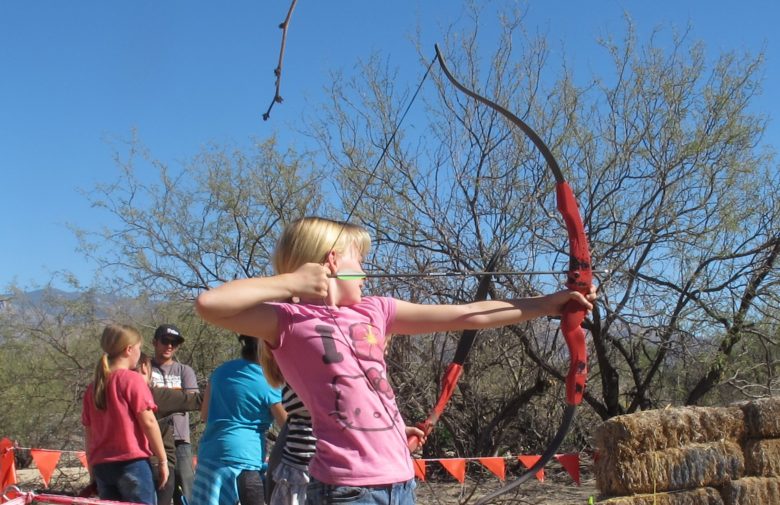
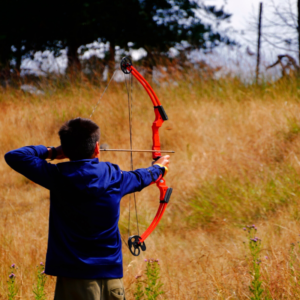
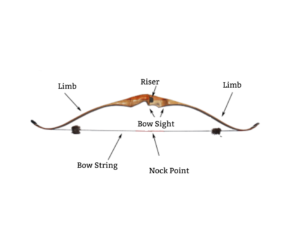
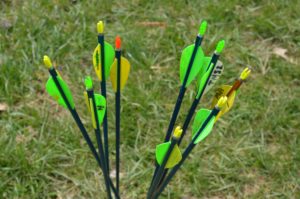
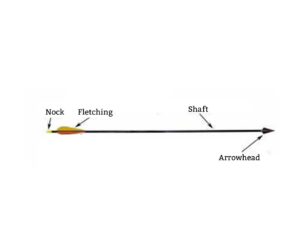

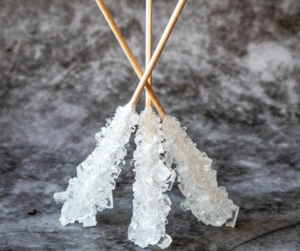

Comments
Wow, I learned so much about archery from your article! I don’t have any nerds at home anymore but I’m always ready to learn something new. Thank you!
I have a quick question for you if you have a second. Do you think it’s better for a new hunter to get started with a longbow or a crossbow. I know longbows are typically more accurate. My friend however was telling me I shouldn’t even consider anything but a crossbow. Thanks in advance for your answer.
Author
I think it depends on what you are most comfortable with and what you are hunting. You are correct that a longbow is more accurate (if you are proficient)and you can fire quicker. Most beginners that I have spoken to are hesitant to use a longbow because it requires more strength. They are quieter than a crossbow and would probably be better for hunting small game. If you are hunting something bigger and looking for more force, I would say go with the crossbow.